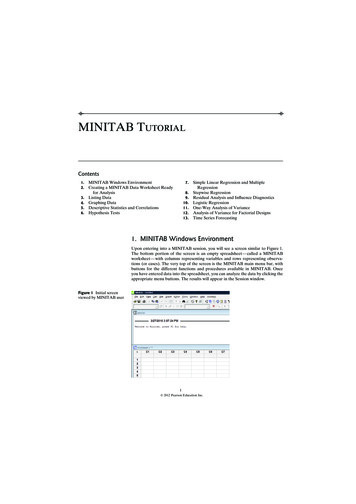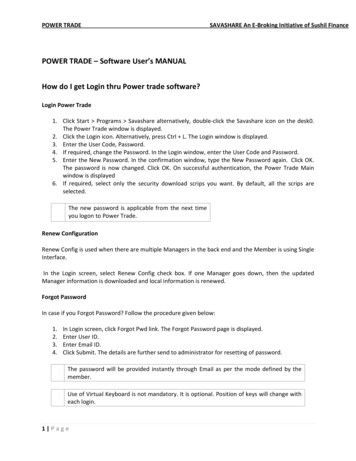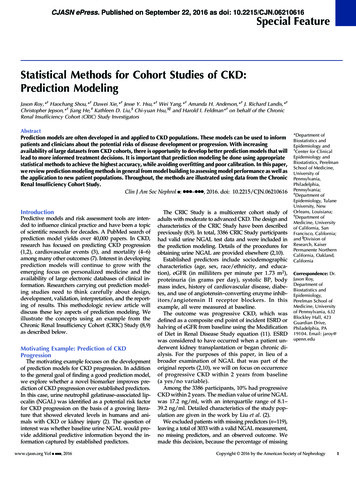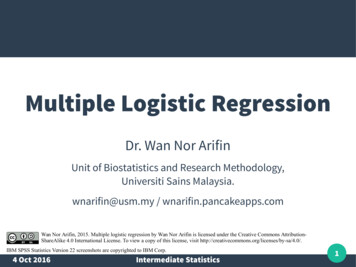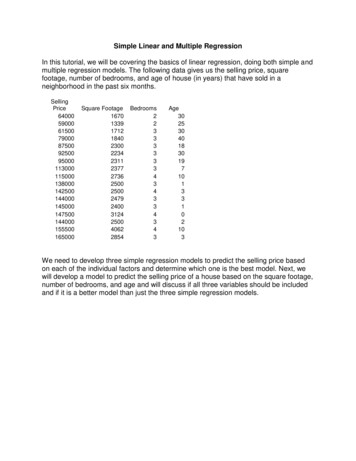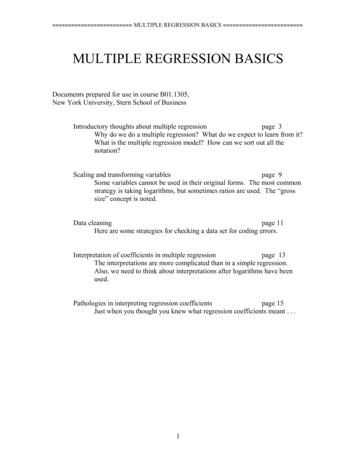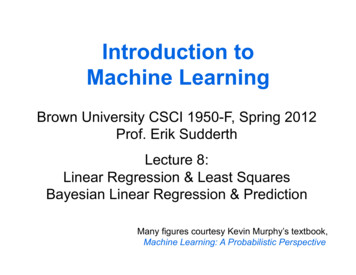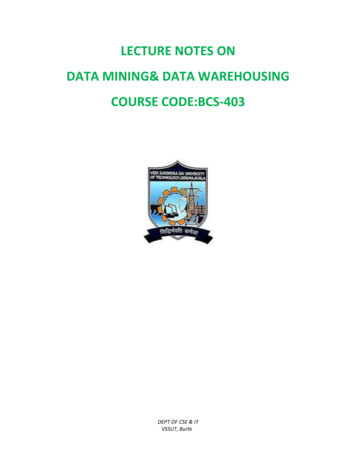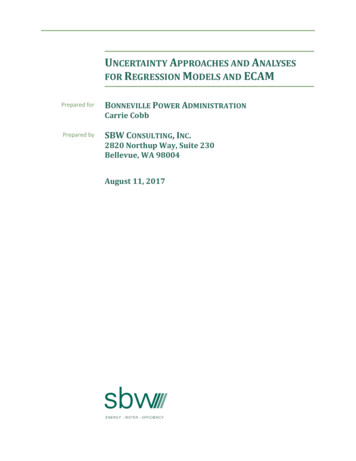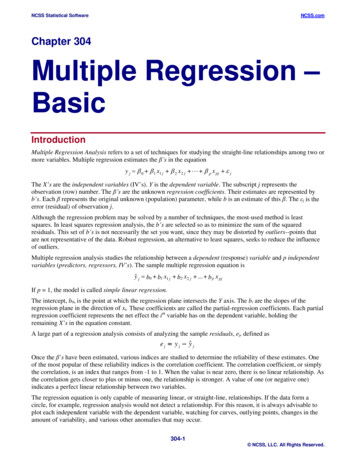
Transcription
NCSS Statistical SoftwareNCSS.comChapter 304Multiple Regression –BasicIntroductionMultiple Regression Analysis refers to a set of techniques for studying the straight-line relationships among two ormore variables. Multiple regression estimates the β’s in the equationy j β 0 β 1 x1 j β 2 x 2 j β p x pj ε jThe X’s are the independent variables (IV’s). Y is the dependent variable. The subscript j represents theobservation (row) number. The β’s are the unknown regression coefficients. Their estimates are represented byb’s. Each β represents the original unknown (population) parameter, while b is an estimate of this β. The εj is theerror (residual) of observation j.Although the regression problem may be solved by a number of techniques, the most-used method is leastsquares. In least squares regression analysis, the b’s are selected so as to minimize the sum of the squaredresiduals. This set of b’s is not necessarily the set you want, since they may be distorted by outliers--points thatare not representative of the data. Robust regression, an alternative to least squares, seeks to reduce the influenceof outliers.Multiple regression analysis studies the relationship between a dependent (response) variable and p independentvariables (predictors, regressors, IV’s). The sample multiple regression equation isyˆ j b0 b1 x1 j b2 x2 j . b p x pjIf p 1, the model is called simple linear regression.The intercept, b0, is the point at which the regression plane intersects the Y axis. The bi are the slopes of theregression plane in the direction of xi. These coefficients are called the partial-regression coefficients. Each partialregression coefficient represents the net effect the ith variable has on the dependent variable, holding theremaining X’s in the equation constant.A large part of a regression analysis consists of analyzing the sample residuals, ej, defined ase j y j y jOnce the β’s have been estimated, various indices are studied to determine the reliability of these estimates. Oneof the most popular of these reliability indices is the correlation coefficient. The correlation coefficient, or simplythe correlation, is an index that ranges from -1 to 1. When the value is near zero, there is no linear relationship. Asthe correlation gets closer to plus or minus one, the relationship is stronger. A value of one (or negative one)indicates a perfect linear relationship between two variables.The regression equation is only capable of measuring linear, or straight-line, relationships. If the data form acircle, for example, regression analysis would not detect a relationship. For this reason, it is always advisable toplot each independent variable with the dependent variable, watching for curves, outlying points, changes in theamount of variability, and various other anomalies that may occur.304-1 NCSS, LLC. All Rights Reserved.
NCSS Statistical SoftwareNCSS.comMultiple Regression – BasicIf the data are a random sample from a larger population and the εj are independent and normally distributed, a setof statistical tests may be applied to the b’s and the correlation coefficient. These t-tests and F-tests are valid onlyif the above assumptions are met.Regression ModelsIn order to make good use of multiple regression, you must have a basic understanding of the regression model.The basic regression model isy β 0 β 1 x1 β 2 x2 β p x p εThis expression represents the relationship between the dependent variable (DV) and the independent variables(IV’s) as a weighted average in which the regression coefficients (β’s) are the weights. Unlike the usual weightsin a weighted average, it is possible for the regression coefficients to be negative.A fundamental assumption in this model is that the effect of each IV is additive. Now, no one really believes thatthe true relationship is actually additive. Rather, they believe that this model is a reasonable first-approximation tothe true model. To add validity to this approximation, you might consider this additive model to be a Taylor-seriesexpansion of the true model. However, this appeal to the Taylor-series expansion usually ignores the ‘localneighborhood’ assumption.Another assumption is that the relationship of the DV with each IV is linear (straight-line). Here again, no onereally believes that the relationship is a straight-line. However, this is a reasonable first approximation.In order obtain better approximations, methods have been developed to allow regression models to approximatecurvilinear relationships as well as non-additivity. Although nonlinear regression models can be used in thesesituations, they add a higher level of complexity to the modeling process. An experienced user of multipleregression knows how to include curvilinear components in a regression model when it is needed.Another issue is how to add categorical variables into the model. Unlike regular numeric variables, categoricalvariables may be alphabetic. Examples of categorical variables are gender, producer, and location. In order toeffectively use multiple regression, you must know how to include categorical IV’s in your regression model.This section shows how NCSS may be used to specify and estimate advanced regression models that includecurvilinearity, interaction, and categorical variables.Representing a Curvilinear RelationshipA curvilinear relationship between a DV and one or more IV’s is often modeled by adding new IV’s which arecreated from the original IV by squaring, and occasionally cubing, them. For example, the regression modelY β 0 β 1 X1 β 2 X 2might be expanded toY β 0 β 1 X1 β 2 X 2 β 3 X12 β 4 X 22 β 5 X1 X 2 β 0 β 1 Z1 β 2 Z2 β 3 Z3 β 4 Z4 β 5 Z5Note that this model is still additive in terms of the new IV’s.One way to adopt such a new model is to create the new IV’s using the transformations of existing variables.304-2 NCSS, LLC. All Rights Reserved.
NCSS Statistical SoftwareNCSS.comMultiple Regression – BasicRepresenting Categorical VariablesCategorical variables take on only a few unique values. For example, suppose a therapy variable has threepossible values: A, B, and C. One question is how to include this variable in the regression model. At first glance,we can convert the letters to numbers by recoding A to 1, B to 2, and C to 3. Now we have numbers.Unfortunately, we will obtain completely different results if we recode A to 2, B to 3, and C to 1. Thus, a directrecode of letters to numbers will not work.To convert a categorical variable to a form usable in regression analysis, we have to create a new set of numericvariables. If a categorical variable has k values, k - 1 new variables must be generated.There are many ways in which these new variables may be generated. You can use the Contrasts data tool inNCSS (Data Window Menu: Data Create Contrast Variables) to automatically create many types of contrastsand binary indicator variables. We will present a few examples here.Indicator VariablesIndicator (dummy or binary) variables are a popular type of generated variables. They are created as follows. Areference value is selected. Usually, the most common value is selected as the reference value. Next, a variable isgenerated for each of the values other than the reference value. For example, suppose that C is selected as thereference value. An indicator variable is generated for each of the remaining values: A and B. The value of theindicator variable is one if the value of the original variable is equal to the value of interest, or zero otherwise.Here is how the original variable T and the two new indicator variables TA and TB look in a short example.TAABBCCTA110000TB001100The generated IV’s, TA and TB, would be used in the regression model.Contrast VariablesContrast variables are another popular type of generated variables. Several types of contrast variables can begenerated. We will present a few here. One method is to contrast each value with the reference value. The valueof interest receives a one. The reference value receives a negative one. All other values receive a zero.Continuing with our example, one set of contrast variables isTAABBCCCA CB10100101-1-1-1-1The generated IV’s, CA and CB, would be used in the regression model.304-3 NCSS, LLC. All Rights Reserved.
NCSS Statistical SoftwareNCSS.comMultiple Regression – BasicAnother set of contrast variables that is commonly used is to compare each value with those remaining. For thisexample, we will suppose that T takes on four values: A, B, C, and D. The generate variables ny other methods have been developed to provide meaningful numeric variables that represent categoricalvariable. We have presented these because they may be generated automatically by NCSS.Representing Interactions of Numeric VariablesThe interaction between two variables is represented in the regression model by creating a new variable that is theproduct of the variables that are interacting. Suppose you have two variables X1 and X2 for which an interactionterm is necessary. A new variable is generated by multiplying the values of X1 and X2 together.X1123205X211224-2Int12640-10The new variable, Int, is added to the regression equation and treated like any other variable during the analysis.With Int in the regression model, the interaction between X1 and X2 may be investigated.Representing Interactions of Numeric and Categorical VariablesWhen the interaction between a numeric IV and a categorical IV is to be included in the model, all proceeds asabove, except that an interaction variable must be generated for each categorical variable.In the following example, the interaction between the categorical variable T and the numeric variable X is created.TAABBCCCA1100-1-1CB0011-1-1X XCA1.2 1.21.4 1.42.304.703.5 -3.51.8 -1.8XCB002.34.7-3.5-1.8When the variables XCA and XCB are added to the regression model, they will account for the interaction betweenT and X.304-4 NCSS, LLC. All Rights Reserved.
NCSS Statistical SoftwareNCSS.comMultiple Regression – BasicRepresenting Interactions Two or More Categorical VariablesWhen the interaction between two categorical variables is included in the model, an interaction variable must begenerated for each combination of the variables generated for each categorical variable.In the following example, the interaction between the categorical variables T and S are generated. Try todetermine the reference value used for variable S.TAABBCCCA1100-1-1CB0011-1-1SDEFDEFS1100100S2 CAS1 CAS2 CBS1 CBS20100010100000000001010-10-100000When the variables, CAS1, CAS2, CBS1, and CBS2 are added to the regression model, they will account for theinteraction between T and S.Possible Uses of Regression AnalysisMontgomery (1982) outlines the following five purposes for running a regression analysis.DescriptionThe analyst is seeking to find an equation that describes or summarizes the relationships in a set of data. Thispurpose makes the fewest assumptions.Coefficient EstimationThis is a popular reason for doing regression analysis. The analyst may have a theoretical relationship in mind,and the regression analysis will confirm this theory. Most likely, there is specific interest in the magnitudes andsigns of the coefficients. Frequently, this purpose for regression overlaps with others.PredictionThe prime concern here is to predict some response variable, such as sales, delivery time, efficiency, occupancyrate in a hospital, reaction yield in some chemical process, or strength of some metal. These predictions may bevery crucial in planning, monitoring, or evaluating some process or system. There are many assumptions andqualifications that must be made in this case. For instance, you must not extrapolate beyond the range of the data.Also, interval estimates require special, so-called normality, assumptions to hold.ControlRegression models may be used for monitoring and controlling a system. For example, you might want tocalibrate a measurement system or keep a response variable within certain guidelines. When a regression model isused for control purposes, the independent variables must be related to the dependent in a causal way.Furthermore, this functional relationship must continue over time. If it does not, continual modification of themodel must occur.304-5 NCSS, LLC. All Rights Reserved.
NCSS Statistical SoftwareNCSS.comMultiple Regression – BasicVariable Selection or ScreeningIn this case, a search is conducted for those independent variables that explain a significant amount of thevariation in the dependent variable. In most applications, this is not a one-time process but a continual modelbuilding process. This purpose is manifested in other ways, such as using historical data to identify factors forfuture experimentationAssumptionsThe following assumptions must be considered when using multiple regression analysis.LinearityMultiple regression models the linear (straight-line) relationship between Y and the X’s. Any curvilinearrelationship is ignored. This is most easily evaluated by scatter plots early on in your analysis. Nonlinear patternscan show up in residual plots.Constant VarianceThe variance of the ε ' s is constant for all values of the X’s. This can be detected by residual plots of ej versus y jor the X’s. If these residual plots show a rectangular shape, we can assume constant variance. On the other hand, ifa residual plot shows an increasing or decreasing wedge or bowtie shape, non-constant variance exists and mustbe corrected.Special CausesWe assume that all special causes, outliers due to one-time situations, have been removed from the data. If not,they may cause non-constant variance, non-normality, or other problems with the regression model.NormalityWe assume the ε ' s are normally distributed when hypothesis tests and confidence limits are to be used.IndependenceThe ε ' s are assumed to be uncorrelated with one another, which implies that the Y’s are also uncorrelated. Thisassumption can be violated in two ways: model misspecification or time-sequenced data.1. Model misspecification. If an important independent variable is omitted or if an incorrect functional formis used, the residuals may not be independent. The solution to this dilemma is to find the properfunctional form or to include the proper independent variables.2. Time-sequenced data. Whenever regression analysis is performed on data taken over time (frequentlycalled time series data), the residuals are often correlated. This correlation among residuals is called serialcorrelation or autocorrelation. Positive autocorrelation means that the residual in time period j tends tohave the same sign as the residual in time period (j-k), where k is the lag in time periods. On the otherhand, negative autocorrelation means that the residual in time period j tends to have the opposite sign asthe residual in time period (j-k).The presence of autocorrelation among the residuals has several negative impacts:1. The regression coefficients are unbiased but no longer efficient, i.e., minimum variance estimates.2. With positive serial correlation, the mean square error may be seriously underestimated. The impact ofthis is that the standard errors are underestimated, the partial t-tests are inflated (show significance whenthere is none), and the confidence intervals are shorter than they should be.304-6 NCSS, LLC. All Rights Reserved.
NCSS Statistical SoftwareNCSS.comMultiple Regression – Basic3. Any hypothesis tests or confidence limits that required the use of the t or F distribution would be invalid.You could try to identify these serial correlation patterns informally, with the residual plots versus time. A betteranalytical way would be to compute the serial or autocorrelation coefficient for different time lags and compare itto a critical value.MulticollinearityCollinearity, or multicollinearity, is the existence of near-linear relationships among the set of independentvariables. The presence of multicollinearity causes all kinds of problems with regression analysis, so you couldsay that we assume the data do not exhibit it.Effects of MulticollinearityMulticollinearity can create inaccurate estimates of the regression coefficients, inflate the standard errors of theregression coefficients, deflate the partial t-tests for the regression coefficients, give false nonsignificant p-values,and degrade the predictability of the model.Sources of MulticollinearityTo deal with collinearity, you must be able to identify its source. The source of the collinearity impacts theanalysis, the corrections, and the interpretation of the linear model. There are five sources (see Montgomery[1982] for details):1. Data collection. In this case, the data has been collected from a narrow subspace of the independentvariables. The collinearity has been created by the sampling methodology. Obtaining more data on anexpanded range would cure this collinearity problem.2. Physical constraints of the linear model or population. This source of collinearity will exist no matterwhat sampling technique is used. Many manufacturing or service processes have constraints onindependent variables (as to their range), either physically, politically, or legally, which will createcollinearity.3. Over-defined model. Here, there are more variables than observations. This situation should be avoided.4. Model choice or specification. This source of collinearity comes from using independent variables thatare higher powers or interactions of an original set of variables. It should be noted that if samplingsubspace of Xj is narrow, then any combination of variables with xj will increase the collinearity problemeven further.5. Outliers. Extreme values or outliers in the X-space can cause collinearity as well as hide it.Detection of CollinearityThe following steps for detecting collinearity proceed from simple to complex.1. Begin by studying pairwise scatter plots of pairs of independent variables, looking for near-perfectrelationships. Also glance at the correlation matrix for high correlations. Unfortunately, multicollinearitydoes not always show up when considering the variables two at a time.2. Next, consider the variance inflation factors (VIF). Large VIF’s flag collinear variables.3. Finally, focus on small eigenvalues of the correlation matrix of the independent variables. An eigenvalueof zero or close to zero indicates that an exact linear dependence exists. Instead of looking at thenumerical size of the eigenvalue, use the condition number. Large condition numbers indicatecollinearity.304-7 NCSS, LLC. All Rights Reserved.
NCSS Statistical SoftwareNCSS.comMultiple Regression – BasicCorrection of CollinearityDepending on what the source of collinearity is, the solutions will vary. If the collinearity has been created by thedata collection, then collect additional data over a wider X-subspace. If the choice of the linear model hasaccented the collinearity, simplify the model by variable selection techniques. If an observation or two hasinduced the collinearity, remove those observations and proceed accordingly. Above all, use care in selecting thevariables at the outset.Centering and Scaling Issues in CollinearityWhen the variables in regression are centered (by subtracting their mean) and scaled (by dividing by theirstandard deviation), the resulting X'X matrix is in correlation form. The centering of each independent variable hasremoved the constant term from the collinearity diagnostics. Scaling and centering permit the computation of thecollinearity diagnostics on standardized variables. On the other hand, there are many regression applicationswhere the intercept is a vital part of the linear model. The collinearity diagnostics on the uncentered data mayprovide a more realistic picture of the collinearity structure in these cases.Multiple Regression ChecklistThis checklist, prepared by a professional statistician, is a flowchart of the steps you should complete to conduct avalid multiple regression analysis. Several of these steps should be performed prior to this phase of the regressionanalysis, but they are briefly listed here again as a reminder. Some of the items may require the use of the moreadvanced Multiple Regression procedure in NCSS. You should complete these tasks in order.Step 1 – Data PreparationScan your data for anomalies, keypunch errors, typos, and so on. You should have a minimum of fiveobservations for each variable in the analysis, including the dependent variable. This discussion assumes that thepattern of missing values is random. All data preparation should be done prior to the use of one of the variableselection strategies.Special attention must be paid to categorical IV’s to make certain that you have chosen a reasonable method ofconverting them to numeric values.Also, you must decide how complicated of a model to use. Do you want to include powers of variables andinteractions between terms?One the best ways to accomplish this data preparation is to run your data through the Data Screening procedure,since it provides reports about missing value patterns, discrete and continuous variables, and so on.Step 2 – Variable SelectionVariable selection seeks to reduce the number of IV’s to a manageable few. There are several variable selectionmethods in regression: Subset Selection, Stepwise Regression, All Possible Regressions, or Multivariate VariableSelection. Each of these variable selection methods has advantages and disadvantages. We suggest that you beginwith the Subset Select procedure since it allows you to look at interactions, powers, and categorical variables.It is extremely important that you complete Step 1 before beginning this step, since variable selection can begreatly distorted by outliers. Every effort should be taken to find outliers before beginning this step.304-8 NCSS, LLC. All Rights Reserved.
NCSS Statistical SoftwareNCSS.comMultiple Regression – BasicStep 3 – Setup and Run the RegressionIntroductionNow comes the fun part: running the program. NCSS is designed to be simple to operate, but it can still seemcomplicated. When you go to run a procedure such as this for the first time, take a few minutes to read throughthe chapter again and familiarize yourself with the issues involved.Enter VariablesThe NCSS panels are set with ready-to-run defaults, but you have to select the appropriate variables (columns ofdata). There should be only one dependent variable and one or more independent variables enumerated. Inaddition, if a weight variable is available from a previous analysis, it needs to be specified.Choose Report OptionsIn multiple linear regression, there is a wide assortment of report options available. As a minimum, you areinterested in the coefficients for the regression equation, the analysis of variance report, normality testing, serialcorrelation (for time-sequenced data), regression diagnostics (looking for outliers), and multicollinearity insights.Specify AlphaMost beginners at statistics forget this important step and let the alpha value default to the standard 0.05. Youshould make a conscious decision as to what value of alpha is appropriate for your study. The 0.05 default cameabout during the dark ages when people had to rely on printed probability tables and there were only two valuesavailable: 0.05 or 0.01. Now you can set the value to whatever is appropriate.Select All PlotsAs a rule, select all residual plots. They add a great deal to your analysis of the data.Step 4 – Check Model AdequacyIntroductionOnce the regression output is displayed, you will be tempted to go directly to the probability of the F-test from theregression analysis of variance table to see if you have a significant result. However, it is very important that youproceed through the output in an orderly fashion. The main conditions to check for relate to linearity, normality,constant variance, independence, outliers, multicollinearity, and predictability. Return to the statistical sectionsand plot descriptions for more detailed discussions.Check 1. Linearity Look at the Residual vs. Predicted plot. A curving pattern here indicates nonlinearity. Look at the Residual vs. Predictor plots. A curving pattern here indicates nonlinearity. Look at the Y versus X plots. For simple linear regression, a linear relationship between Y and X in a scatterplot indicates that the linearity assumption is appropriate. The same holds if the dependent variable is plottedagainst each independent variable in a scatter plot. If linearity does not exist, take the appropriate action and return to Step 2. Appropriate action might be to addpower terms (such as Log(X), X squared, or X cubed) or to use an appropriate nonlinear model.304-9 NCSS, LLC. All Rights Reserved.
NCSS Statistical SoftwareNCSS.comMultiple Regression – BasicCheck 2. Normality Look at the Normal Probability Plot. If all of the residuals fall within the confidence bands for the NormalProbability Plot, the normality assumption is likely met. One or two residuals outside the confidence bandsmay be an indicator of outliers, not non-normality. Look at the Normal Assumptions Section. The formal normal goodness of fit tests are given in the NormalAssumptions Section. If the decision is accepted for the Normality (Omnibus) test, there is no evidence thatthe residuals are not normal. If normality does not exist, take the appropriate action and return to Step 2. Appropriate action includesremoving outliers and/or using the logarithm of the dependent variable.Check 3. Non-constant Variance Look at the Residual vs. Predicted plot. If the Residual vs. Predicted plot shows a rectangular shape instead ofan increasing or decreasing wedge or a bowtie, the variance is constant. Look at the Residual vs. Predictor plots. If the Residual vs. Predictor plots show a rectangular shape, insteadof an increasing or decreasing wedge or a bowtie, the variance is constant. If non-constant variance does not exist, take the appropriate action and return to Step 2. Appropriate actionincludes taking the logarithm of the dependent variable or using weighted regression.Check 4. Independence or Serial Correlation If you have time series data, look at the Serial-Correlations Section. If none of the serial correlations in theSerial-Correlations Section are greater than the critical value that is provided, independence may be assumed. Look at the Residual vs. Row plot. A visualization of what the Serial-Correlations Section shows will beexhibited by adjacent residuals being similar (a roller coaster trend) or dissimilar (a quick oscillation). If independence does not exist, use a first difference model and return to Step 2. More complicated choicesrequire time series models.Check 5. Outliers Look at the Regression Diagnostics Section. Any observations with an asterisk by the diagnostics RStudent,Hat Diagonal, DFFITS, or the CovRatio, are potential outliers. Observations with a Cook’s D greater than1.00 are also potentially influential. Look at the Dfbetas Section. Any Dfbetas beyond the cutoff of 2 Look at the Rstudent vs. Hat Diagonal plot. This plot will flag an observation that may be jointly influentialby both diagnostics. If outliers do exist in the model, go to robust regression and run one of the options there to confirm theseoutliers. If the outliers are to be deleted or down weighted, return to Step 2.N indicate influential observations.Check 6. Multicollinearity Look at the Multicollinearity Section. If any variable has a variance inflation factor greater than 10,collinearity could be a problem. Look at the Eigenvalues of Centered Correlations Section. Condition numbers greater than 1000 indicatesevere collinearity. Condition numbers between 100 and 1000 imply moderate to strong collinearity. Look at the Correlation Matrix Section. Strong pairwise correlation here may give some insight as to thevariables causing the collinearity.304-10 NCSS, LLC. All Rights Reserved.
NCSS Statistical SoftwareNCSS.comMultiple Regression – Basic If multicollinearity does exist in the model, it could be due to an outlier (return to Check 5 and then Step 2) ordue to strong interdependencies between independent variables. In the latter case, return to Step 2 and try adifferent variable selection procedure.Check 7. Predictability Look at the PRESS Section. If the Press R2 is almost as large as the R2, you have done as well as could beexpected. It is not unusual in practice for the Press R2 to be half of the R2. If R2 is 0.50, a Press R2 of 0.25would be unacceptable. Look at the Predicted Values with Confidence Limits for Means and Individuals. If the confidence limits aretoo wide to be practical, you may need to add new variables or reassess the outlier and collinearitypossibilities. Look at the Residual Report. Any observation that has percent error grossly deviant from the values of mostobservations is an indication that this observation may be impacting predictability. Any changes in the model due to poor predictability require a return to Step 2.Step 5 – Record Your ResultsSince multiple regression can be quite involved, it is best make notes of why you did what you did at differentsteps of the analysis. Jot down what decisions you made and what you have found. Explain what you did, whyyou did it, what conclusions you reached, which outliers you deleted, areas for further investigation, and so on. Besure to examine the following sections closely and in the indicated order:1. Analysis of Variance Section. Check for the overall significance of the model.2. Regression Equation and Coefficient Sections. Significant individual variables are noted here.Regression analysis is a complicated statistical tool that frequently demands revisions of the model. Your notes ofthe analysis process as well as of the interpretation will be worth their weigh
Basic Introduction Multiple Regression Analysis refers to a set of techniques for studying the straight-line relationships among two or more variables. Multiple regression estimates the β’s in the equation y β 0 β 1 x 1j β 2 x 2 j β p x pj ε j The X’s are the i
